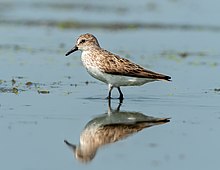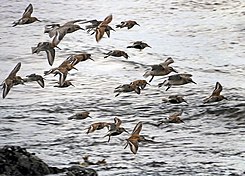
Charadriiformes is a diverse order of small to medium-large birds. It includes about 390 species and has members in all parts of the world. Most charadriiform birds live near water and eat invertebrates or other small animals; however, some are pelagic (seabirds), others frequent deserts, and a few are found in dense forest. Members of this group can also collectively be referred to as shorebirds.

An auk or alcid is a bird of the family Alcidae in the order Charadriiformes. The alcid family includes the murres, guillemots, auklets, puffins, and murrelets. The family contains 25 extant or recently extinct species that are divided into 11 genera.

A phalarope is any of three living species of slender-necked shorebirds in the genus Phalaropus of the bird family Scolopacidae.

Scolopacidae is a large family of shorebirds, or waders, which mainly includes many species known as sandpipers, but also others such as curlews and snipes. The majority of these species eat small invertebrates picked out of the mud or soil. Different lengths of bills enable different species to feed in the same habitat, particularly on the coast, without direct competition for food.

The crab-plover or crab plover is a bird related to the waders, but sufficiently distinctive to merit its own family Dromadidae. Its relationship within the Charadriiformes is unclear, some have considered it to be closely related to the thick-knees, or the pratincoles, while others have considered it closer to the auks and gulls. It is the only member of the genus Dromas and is unique among waders in making use of ground warmth to aid incubation of the eggs.

The ibisbill is a bird related to the waders, but sufficiently distinctive to merit its own family Ibidorhynchidae. It is grey with a white belly, red legs and long down-curved bill, and a black face and black breast band. It occurs on the shingle riverbanks of the high plateau of central Asia and the Himalayas.

Buttonquail or hemipodes are members of a small family of birds, Turnicidae, which resemble, but are not closely related to, the quails of Phasianidae. They inhabit warm grasslands in Asia, Africa, Europe, and Australia. There are 18 species in two genera, with most species placed in the genus Turnix and a single species in the genus Ortyxelos.

The suborder Lari is the part of the order Charadriiformes that includes the gulls, terns, skuas and skimmers; the rest of the order is made up of the waders and snipes. The auks are now placed into the Lari too, following recent research. Sometimes, the buttonquails are also placed here, but the molecular data and fossil record rather suggests they are a quite basal offshoot along with the snipe-like and aberrant waders.

The ruff is a medium-sized wading bird that breeds in marshes and wet meadows across northern Eurasia. This highly gregarious sandpiper is migratory and sometimes forms huge flocks in its winter grounds, which include southern and western Europe, Africa, southern Asia and Australia.

The curlew sandpiper is a small wader that breeds on the tundra of Arctic Siberia.

The Eurasian dotterel, also known in Europe as just dotterel, is a small wader in the plover family of birds. It is the only species placed in the genus Eudromias.

Kittlitz's plover is a small shorebird in the family Charadriidae that breeds near coastal and inland saltmarshes, sandy or muddy riverbanks or alkaline grasslands with short vegetation. It is native to much of Sub-Saharan Africa, the Nile Delta and Madagascar. It is thought to be mainly polygamous and has monomorphic plumage.

Actitis is a small genus of waders, comprising just two very similar bird species.

The comb-crested jacana, also known as the lotusbird or lilytrotter, is the only species of jacana in the genus Irediparra. Like other jacana species, it is adapted to the floating vegetation of tropical freshwater wetlands.

The Kentish plover is a small wader of the family Charadriidae that breeds on the shores of saline lakes, lagoons, and coasts, populating sand dunes, marshes, semi-arid desert, and tundra. Both male and female birds have pale plumages with a white underside, grey/brown back, dark legs and a dark bill; however, additionally the male birds also exhibit very dark incomplete breast bands, and dark markings either side of their head, therefore the Kentish plover is regarded as sexually dimorphic.

The pied plover, also known as the pied lapwing, is a species of bird in the family Charadriidae. It is a bird of least concern according to the IUCN and can be found in northern South America. The species name cayanus refers to Cayenne, the capital of French Guiana, where the pied plover can be found.
Telmatornis is a valid prehistoric bird genus which has been placed in Charadriiformes. It apparently lived in the Late Cretaceous; its remains were found in the early Maastrichtian Navesink Formation of New Jersey. A single species is included today, Telmatornis priscus.

Gruimorphae is a clade of birds that contains the orders Charadriiformes and Gruiformes identified by molecular analysis. This grouping has had historical support, as various charadriiform families such as the families Pedionomidae and Turnicidae were classified as gruiforms. It may also have support from the fossil record since the discovery of Nahmavis from the Early Eocene of North America.

Tamás Székely is a Hungarian evolutionary biologist and conservationist. He is the Professor of Biodiversity at the University of Bath and he holds an Honorary Professor position at the University of Debrecen, Hungary. He is also the Director of the Debrecen Biodiversity Centre. His 1999 article, Brood Desertion in Kentish Plover, laid the groundwork for the demographic hypothesis of sex roles' origin, demonstrating the social environment's influence on parental care dynamics. Székely has won multiple academic and conservation awards.
Charadriisimilis is an extinct genus of charadriiform birds from the Early Eocene (Ypresian) London Clay of Walton-on-the-Naze, United Kingdom. The genus contains a single species, Charadriisimilis essexensis, known from partial postcranial remains.























